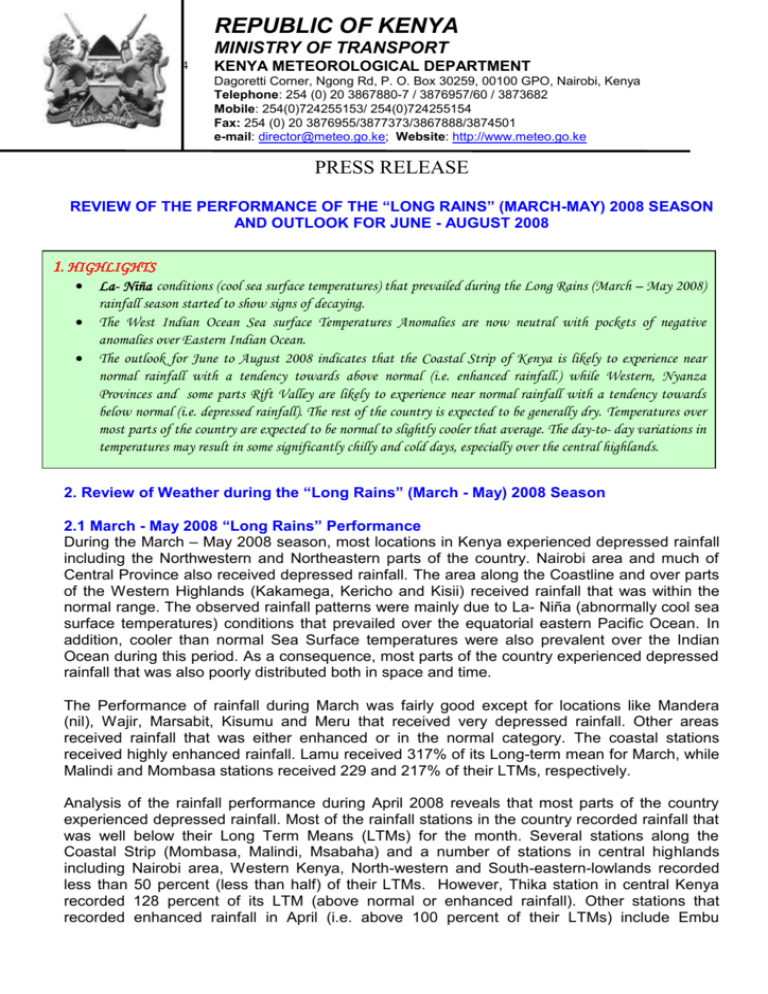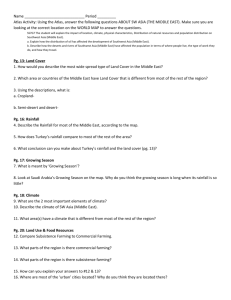Seasonal Forecast
advertisement

REPUBLIC OF KENYA MINISTRY OF TRANSPORT 4 KENYA METEOROLOGICAL DEPARTMENT Dagoretti Corner, Ngong Rd, P. O. Box 30259, 00100 GPO, Nairobi, Kenya Telephone: 254 (0) 20 3867880-7 / 3876957/60 / 3873682 Mobile: 254(0)724255153/ 254(0)724255154 Fax: 254 (0) 20 3876955/3877373/3867888/3874501 e-mail: director@meteo.go.ke; Website: http://www.meteo.go.ke PRESS RELEASE REVIEW OF THE PERFORMANCE OF THE “LONG RAINS” (MARCH-MAY) 2008 SEASON AND OUTLOOK FOR JUNE - AUGUST 2008 1. HIGHLIGHTS La- Niña conditions (cool sea surface temperatures) that prevailed during the Long Rains (March – May 2008) rainfall season started to show signs of decaying. The West Indian Ocean Sea surface Temperatures Anomalies are now neutral with pockets of negative anomalies over Eastern Indian Ocean. The outlook for June to August 2008 indicates that the Coastal Strip of Kenya is likely to experience near normal rainfall with a tendency towards above normal (i.e. enhanced rainfall.) while Western, Nyanza Provinces and some parts Rift Valley are likely to experience near normal rainfall with a tendency towards below normal (i.e. depressed rainfall). The rest of the country is expected to be generally dry. Temperatures over most parts of the country are expected to be normal to slightly cooler that average. The day-to- day variations in temperatures may result in some significantly chilly and cold days, especially over the central highlands. 2. Review of Weather during the “Long Rains” (March - May) 2008 Season 2.1 March - May 2008 “Long Rains” Performance During the March – May 2008 season, most locations in Kenya experienced depressed rainfall including the Northwestern and Northeastern parts of the country. Nairobi area and much of Central Province also received depressed rainfall. The area along the Coastline and over parts of the Western Highlands (Kakamega, Kericho and Kisii) received rainfall that was within the normal range. The observed rainfall patterns were mainly due to La- Niña (abnormally cool sea surface temperatures) conditions that prevailed over the equatorial eastern Pacific Ocean. In addition, cooler than normal Sea Surface temperatures were also prevalent over the Indian Ocean during this period. As a consequence, most parts of the country experienced depressed rainfall that was also poorly distributed both in space and time. The Performance of rainfall during March was fairly good except for locations like Mandera (nil), Wajir, Marsabit, Kisumu and Meru that received very depressed rainfall. Other areas received rainfall that was either enhanced or in the normal category. The coastal stations received highly enhanced rainfall. Lamu received 317% of its Long-term mean for March, while Malindi and Mombasa stations received 229 and 217% of their LTMs, respectively. Analysis of the rainfall performance during April 2008 reveals that most parts of the country experienced depressed rainfall. Most of the rainfall stations in the country recorded rainfall that was well below their Long Term Means (LTMs) for the month. Several stations along the Coastal Strip (Mombasa, Malindi, Msabaha) and a number of stations in central highlands including Nairobi area, Western Kenya, North-western and South-eastern-lowlands recorded less than 50 percent (less than half) of their LTMs. However, Thika station in central Kenya recorded 128 percent of its LTM (above normal or enhanced rainfall). Other stations that recorded enhanced rainfall in April (i.e. above 100 percent of their LTMs) include Embu (119%), Voi (118%), Wajir (113%) and Kisii (109%) while Moyale, Machakos, Meru and Kakamega stations recorded between 75 and 100 percent of their LTMs. The above rainfall was, however, poorly distributed in time and space over the entire country. Much of the rainfall was recorded in the second and third week of the month. Out of the 341.4mm recorded at Embu station during the month, more than 210mm was recorded in three days (on 20th, 21st and 23rd April) with the heaviest storm amounting to 116.9mm being observed on 21st April. The month of May 2008 was dry over many locations especially in Central, Northern and Eastern Kenya. Stations in these areas recorded less than 50% of their expected Long-Term Means. In general, the seasonal rainfall was poorly distributed with long dry spells in-between episodic heavy falls. 3 Forecast for June - August 2008 Season June –July-August (JJA) constitutes an important rainfall season over the North Rift Valley region of Kenya and significantly contributes towards grain production from the region. The Coastal strip also receives significant rainfall during period. Over much of the country, the season is characterized by generally cool and dry conditions with some attendant impacts. 3.1 Rainfall Outlook The rainfall outlook for June-July-August 2008 season indicates that: i. The following areas (shown in yellow in the figure) are expected to receive nearnormal rainfall tending to below normal (depressed): Western Province (Busia, Butere, Mumias, Vihiga, Kakamega, Bungoma, etc.), Nyanza Province (Kisumu,Siaya, Migori, Kisii, Kuria, Nyamira, Borabu, Gucha,etc); Northern part of the Rift Valley Province ( Trans Nzoia, Uasin Gishu, etc) and the Central part of the Rift Valley Province (Molo, Kericho, Bomet,Nandi, Sotik etc). ii. The following areas (shown in grey in the figure) are expected to be generally dry: Much of Central Province (Nyandarua, Nyeri, Thika, Murang’a, Kirinyaga, Mwea, Maragua, etc.); Nairobi Province (Westlands, Embakasi, Kasarani, Dagoretti, etc); Southern part of the Rift Valley Province (Narok, Kajiado, Ngong, Isinya, Namanga, Loitoktok,etc.); the extreme Northern part of the Rift Valley Province (Turkana, Pokot etc); Eastern Province (Embu, Meru, Tharaka, Imenti, Mwingi, Machakos, Makueni, Kibwezi, Marsabit, North Horr, Moyale etc); North Eastern Province (Garissa, Ijara, Wajir, Mandera, Elwalk, etc). However, parts of the Central Highlands and Nairobi area are likely to experience occasional light rains and drizzles. Figure3: JJA 2008 Rainfall forecast 2 iii. The following areas (shown in green in the figure) are likely to experience near-normal rainfall with a tendency towards above-normal (i.e enhanced rainfall): The Coast Province (Malindi, Lamu, Kilifi, Voi, Mombasa, Tana River, Kwale, Msambweni, Kinango, Lungalunga, etc). 3.2. Temperature Forecast Based on the prevailing and expected Sea Surface Temperature (SSTs) anomalies over the Indian and Atlantic Oceans as well as other Synoptic, Mesoscale and local factors that affect the climate of Kenya, and coupling outputs from other centers, the temperatures over Kenya are expected to be normal to slightly cooler that average. The day-to- day variations in temperatures may result in some significantly chilly and cold days, especially over the central highlands. 4 Potential Impacts 4.1 Agriculture and Food Security Sector In the agricultural areas of North Rift Valley province where rainfall is expected to be nearnormal tending to below normal, the farming communities should take advantage of the available rainfall and maximize crop yield through appropriate land-use management. It is advisable that farmers work closely with the Ministry of Agriculture on ways of optimizing the expected rainfall. In the highlands of Central and Eastern provinces, the light rainfall and drizzles expected in this cool cloudy season will contribute towards some crop production albeit with reduced yields. 4.2 Livestock development sector This sector’s activities are mainly concentrated in the Arid and Semi-Arid (ASALs) areas of the country. These are the same areas where the March-May seasonal rainfall was depressed. Problems of water scarcity as well as further pasture deterioration are likely. Close monitoring of the conditions on the ground and contingency measures such as destocking of animals, hay stocking and rehabilitation of boreholes and other watering points are necessary in order to adequately build the resilience of resident households and communities to cope with the situation. The anticipated water and pasture related problems especially in the ASAL areas are likely to occasion human/human and human/wildlife conflicts over these dwindling resources. Measures should therefore be put in place by the administration and support institutions to ameliorate these conflicts. 4.3 Energy Sector The Tana and Turkwel catchments are expected to experience insignificant rainfall according to the climatology of June – August season. Given that the March- May season was poor, there is need for the hydro energy sector to control the water in the hydro-dams located along these rivers to ensure optimal hydro-electricity generation and distribution during the season 4.4 Transport sector Cloudy conditions are likely to dominate during the forthcoming season especially over the highland areas. Light rains, drizzle and foggy conditions are also expected to pose hazards at airports and on the roads. Utmost care is therefore required by all road users to avoid accidents. 4.5 Environmental management Dry conditions expected during the season are likely to trigger fires which may destroy forests and infrastructure as well as perennial crops such as tea, coffee and sugarcane. Relevant 3 authorities are therefore advised to be on the watch out for such incidents and put mechanisms in place to control such fires whenever they arise. 4.6 Water Resources Management and Development Sector Water resources for drinking, sanitation and industrial use are expected to be stretched in major cities especially those located in areas expected to receive little or no rainfall during June-August 2008 period. The municipalities are advised to take stock of the water resources available/deficits and build necessary capacities. 4.7 Health and Public Safety Water and vector borne diseases associated with water scarcity and poor sanitation may emerge in areas expected to receive depressed rainfall. Health authorities are, therefore, expected to be on the look out and equip hospitals with necessary drugs to be able to deal with such situations as they arise. The use of “jikos” in enclosed spaces during the cold and chilly conditions in the highlands and Nairobi areas could pose risks of carbon monoxide poisoning during the coming season. Transmission of respiratory diseases is also likely to be prevalent as people enclose themselves to escape the cold conditions. DR. JOSEPH R. MUKABANA, M.B.S. DIRECTOR OF METEOROLOGICAL SERVICES & PERMANENT REPRESENTATIVE OF KENYA WITH THE WORLD METEOROLOGICAL ORGANIZATION 4







